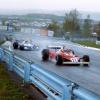
Comparison Between V12 and W12 F1 Engines
#1

Posted 10 August 2001 - 07:56
Comparison Between V12 and W12 F1 Engines
It's a big pdf file but it's worth it. Lots to talk about.
#3

Posted 10 August 2001 - 15:10
#4

Posted 10 August 2001 - 16:47
#5

Posted 10 August 2001 - 18:02
M.L. Anderson
#6

Posted 10 August 2001 - 19:02
#7

Posted 10 August 2001 - 19:26
The theory of a W format engines seems to be gathering alot of creedance in the forums recently, the graphic describing the frontal layout of engine gives me a headache how do you neatly package that lot...? Exhaust pipes running next to induction stacks, lots of heat transfer, where would the exhausts blow out of the sidepods, as a designer I love symetry, the W12 makes my nose bleed....!
Also would the layout not also give torsional problems such as have been rumoured with the renault 111V.
#8

Posted 10 August 2001 - 21:13
#9

Posted 11 August 2001 - 00:34
There is reason in this day and age for these engines to be considered in production applications. The need to keep engines short for transverse mounting with front wheel drive may lead some manufacturers to try them even if only for marketing advantages. "We offer triple overhead cams!"
#10

Posted 11 August 2001 - 00:44
You've heard of quad cam engines? Introducing the sex cam! That should get a few peeking into the engine compartment.
#11

Posted 11 August 2001 - 03:57
#12

Posted 11 August 2001 - 06:55
Okay, okay!! this is only a 1¢ not even a 2¢.
#13

Posted 11 August 2001 - 07:09
Originally posted by BRG
Has anyone made a W12 that really worked? Ignoring the Life fiasco, I know that VW are flirting with the idea
I believe the VW "W12" is two of their VR6 engines "put together" (in a way similar to how two inline 4s are "put together" to make a V8)
[edit for these links:]
http://www.ukcar.com...gine/vr/w12.htm
http://www.fortuneci...e_packaging.htm
#14

Posted 11 August 2001 - 07:53
I took some of their figures and modeled a single piston / crank pin in Derive (mathmatical software), and got some results for force and acceleration that stunned me.
@ 18,000 rpm, 41mm stroke, 96mm conn rod length, 290gram pistons, 277g conn rods, 11.3Kg crank shaft:
- I got the same mean piston speed (24.1 m/s), but the maximum speed is much higer, at 38.6 m/s @ +/- 78 degrees of TDC.
- Fot the crank pins, centrifugal force (my lecturer would get upset here, as it doesn't actually exist), assuming 1/8th of the mass of the crank is in each crank pins (they don't say in the document, but 11.3kg crank and 4 crank pins...), would result in the crank pins weighing 10.5 tonnes (1.4kg @ 7,400 g's, 23,000 lbs) each. I assume the counter weight would weigh the same. This is a constant force per crank pin.
- Maximum piston acceleration is over 8,600 g's at TDC!!!! (5,600 at BDC)
- reciprocating mass = piston mass + 1/3 conn rod mass = 382g (0.84lb). @ 8,600g's = 3.3 tonne! (7,200 lb). This is per cylinder! This is the weight at TDC, it 'only' weighs 2.1 tonne @ BDC, so there is a total weight transfer of 5.4 tonne (12,000lb), 18,000 TIMES PER SECOND!.
These figures may be old news for the old hats, but for an engineering novice, I'm pretty impressed that these engines hold together at all! I've a new found respect for F1 engineers (it was pretty high before).
None of this is specific to a W12, I just used the engines in the articles for masses, stroke, conn rod lenghts, etc..
Oh, yeah, these are just figures for a free spinning engine. Add the forces due to compression and combustion strokes....
#15

Posted 11 August 2001 - 08:43
#16

Posted 11 August 2001 - 16:29
#17

Posted 11 August 2001 - 17:38
#18

Posted 11 August 2001 - 20:51
Originally posted by desmo
OT: I would like to put this article on my hardrive rather than having to download it every time I'd like to have a look.
desmo:
I am curious about how long it takes you to down load and open this PDF? On this T1 connection it's taking me about 20 sec. In any event something like this I usually print out for easier reading.
Rgds;
#19

Posted 12 August 2001 - 05:24
The authors of the paper, Mattarelli and Marchetti are heavyweights in the field. I'm not convinced the idea (a W12 F1 engine) doesn't have real merit. It seems to me that the packaging issues are the most daunting.
"For the V12, the angle between the banks is 75 degrees,
One drawback of the W12 is the position of the exhaust
manifolds of the central bank, which are very close to the
intake telescopic tapers and can be disturbing for the
snorkel design. However, the amount of heat transferred
from exhaust to intake gas should be quite easy to limit."
This is perhaps at least a trifle optimistic. Of couse, it seems likely we'll never know as the FIA has pretty much killed any innovations of this significance.
I was more interested in the stuff on V10 cranks, the detail of the working drawing of the crank throws, the stuff like component weights and dimensions.
Advertisement
#20

Posted 12 August 2001 - 16:34
While W12 engines have been proven, some questions I have are, engine hp relative to its weight, and c.g., (seems like a fair amount of mass up top). The VWW12 is the closest to being turnkey I understand. And given the complexity of the valvetrain and cams, I'd be pretty impressed that these engine would twist as high as they do and last.
I'll have to copy this one into my library as well...
It's a shame the FIA just doesn't go with a fixed liter rule and open configuration. F1 is supposed to be about the exploration and implementation of automotive technologies exercised in motorsport.
Ideas on engine configuration and design would flourish.
Regards -
Richard
P.S. Bet you can hardly wait for cable...
#21

Posted 12 August 2001 - 20:16
I agree with rdrcr, that the FIA needs to allow more flexibility with the configurations and number of cylinders. I'm still sore about
Toyota's V12 being disallowed.
#22

Posted 13 August 2001 - 00:20
#23

Posted 13 August 2001 - 00:42
I've heard that several production cars (Ferraris, Porsches) have 'horizontally opposed' engines, could someone explain why they can't be adapted to F1? If you're after a low CoM, that'd have to be the optimum. Why all this excitment over 115 degrees, why not go 180?
#24

Posted 14 August 2001 - 18:45
It's been discussed, so search for the thread (as I am much too lazy to do so for you
#25

Posted 15 August 2001 - 09:00




















